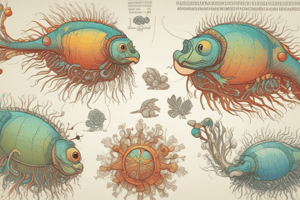Podcast
Questions and Answers
What was the first characteristic of pea plants that Mendel experimented with?
What was the first characteristic of pea plants that Mendel experimented with?
- Flower color (correct)
- Stem length
- Leaf shape
- Root structure
What is the generation of offspring produced by cross-pollination of two parent plants?
What is the generation of offspring produced by cross-pollination of two parent plants?
- F2 generation
- F3 generation
- P generation
- F1 generation (correct)
What is the term for the type of experiment Mendel conducted with pea plants?
What is the term for the type of experiment Mendel conducted with pea plants?
- Monohybrid cross (correct)
- Polyhybrid cross
- Hybridization
- Dihybrid cross
What did Mendel observe in the F2 generation of pea plants?
What did Mendel observe in the F2 generation of pea plants?
What did Mendel assume about the inherited factors for flower color?
What did Mendel assume about the inherited factors for flower color?
What is the term for the principle that states each pair of alleles separates from each other during gamete formation?
What is the term for the principle that states each pair of alleles separates from each other during gamete formation?
How many pea plant characteristics did Mendel experiment with?
How many pea plant characteristics did Mendel experiment with?
What was the ratio of purple-flowered to white-flowered plants in the F2 generation?
What was the ratio of purple-flowered to white-flowered plants in the F2 generation?
What is the primary reason why genetic variation is crucial for the survival of species?
What is the primary reason why genetic variation is crucial for the survival of species?
What is an advantage of asexual reproduction?
What is an advantage of asexual reproduction?
Which process produces haploid gametes in humans?
Which process produces haploid gametes in humans?
What is the result of crossing over during meiosis?
What is the result of crossing over during meiosis?
What is the primary disadvantage of asexual reproduction?
What is the primary disadvantage of asexual reproduction?
What is the term for the process by which homologous pairs line up randomly during meiosis?
What is the term for the process by which homologous pairs line up randomly during meiosis?
What is the result of meiosis in humans?
What is the result of meiosis in humans?
What is a change in the genetic material?
What is a change in the genetic material?
Flashcards are hidden until you start studying
Study Notes
Mendel's Experiment with Pea Plants
- Mendel experimented with one characteristic of pea plants at a time, starting with flower color.
- He cross-pollinated purple- and white-flowered parent plants, referred to as the P (parent) generation.
- The F1 generation resulted from cross-pollination of the P generation and contained all purple flowers.
- The F2 generation resulted from self-pollination of F1 plants and contained 75% purple flowers and 25% white flowers.
F1 and F2 Generations
- The F1 generation is the offspring of the P generation, and all plants in this generation had purple flowers.
- Mendel assumed that inherited factors produce white and purple flowers.
- He wondered if the white-flower factor disappeared in the F1 generation.
Law of Segregation
- Mendel's experiment showed that one value of a characteristic disappeared in the F1 plants and reappeared in the F2 plants.
- For each of the seven pea plant characteristics, 75% of F2 plants had one value and 25% had the other.
- Mendel formulated the law of segregation, which states that:
- There are two factors controlling a characteristic, one of which dominates the other.
- These factors separate and go to different gametes when a parent reproduces.
Genetic Variation and Survival
- Genetic variation is crucial for the survival of species on Earth as it allows populations to adapt to changing conditions and prevents extinction.
Types of Reproduction
- Asexual reproduction requires only one individual to produce offspring and is often seen in simple organisms like bacteria and protists.
- Advantages of asexual reproduction include rapid reproduction, no need to find a mate, and no need to care for offspring.
- Disadvantages of asexual reproduction include no genetic diversity, inability to adapt to changing conditions easily, and proneness to extinction.
- Sexual reproduction requires two individuals to produce offspring and provides genetic diversity, reducing the chance of extinction.
- Advantages of sexual reproduction include genetic diversity and reduced extinction risk.
- Disadvantages of sexual reproduction include energy expenditure to find a mate, slower reproduction rate, and uncertainty of reproduction.
Meiosis
- Meiosis produces haploid gametes (egg and sperm in humans) through Interphase, Meiosis I, and Meiosis II.
- Meiosis I produces two haploid cells with attached sister chromatids.
- Meiosis II produces four haploid cells.
- Only cells in human ovaries and testes undergo meiosis.
- Meiosis for sperm production is called spermatogenesis, while meiosis for egg production is called oogenesis.
- Oogenesis produces only one large egg cell.
Meiosis and Genetic Diversity
- Meiosis causes genetic diversity in two ways: independent assortment and crossing over.
- Independent assortment allows for random alignment of homologous pairs during Meiosis I, resulting in many variations.
- Crossing over involves the exchange of parts between homologous pairs, allowing for an infinite number of new combinations.
Meiosis and Mutations
- A mutation is a change in genetic material that can occur during meiosis and be passed on to offspring.
- Mutations can occur at the chromosome or gene level.
- Nondisjunction is a type of chromosome mutation where chromosomes fail to separate during Meiosis, resulting in egg or sperm with incorrect chromosome numbers.
- Nondisjunction can lead to genetic syndromes depending on the affected chromosome.
- Mutations can also occur in the DNA code at the gene level, which will be discussed further in the next unit.
Studying That Suits You
Use AI to generate personalized quizzes and flashcards to suit your learning preferences.




